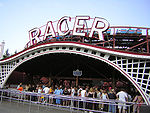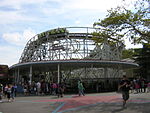PRR Port Perry Bridge
Bridges completed in 1903Bridges in Allegheny County, PennsylvaniaBridges over the Monongahela RiverHistoric American Engineering Record in PennsylvaniaNorfolk Southern Railway bridges ... and 3 more
Pennsylvania Railroad bridgesPennsylvania bridge (structure) stubsRailroad bridges in Pennsylvania

The PPR Port Perry Bridge is a truss bridge that carries the Port Perry Branch of the Norfolk Southern Railway across the Monongahela River between the Pennsylvania towns of North Versailles Township, and Duquesne. The bridge was built to serve the Pennsylvania Railroad, to provide better access to industrial sites, and to help through trains bypass downtown Pittsburgh. Today, the bridge and corresponding route serve a similar purpose and are used to allow high-level loads, especially double-stacked container cars, to avoid the narrower routes through Pittsburgh.
Excerpt from the Wikipedia article PRR Port Perry Bridge (License: CC BY-SA 3.0, Authors, Images).PRR Port Perry Bridge
Great Allegheny Passage,
Geographical coordinates (GPS) Address External links Nearby Places Show on map
Geographical coordinates (GPS)
| Latitude | Longitude |
|---|---|
| N 40.3871 ° | E -79.8513 ° |
Address
PRR Port Perry Bridge
Great Allegheny Passage
15104
Pennsylvania, United States
Open on Google Maps











